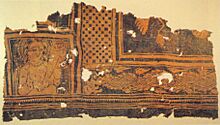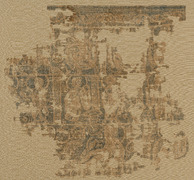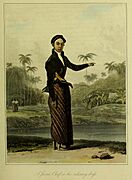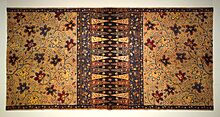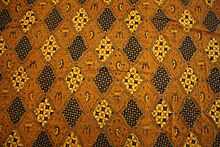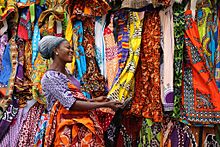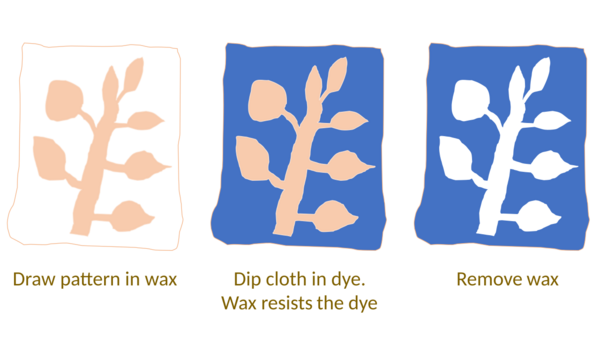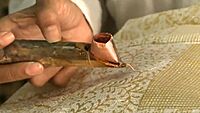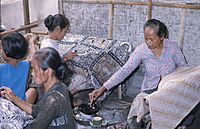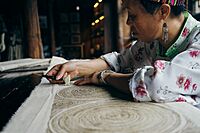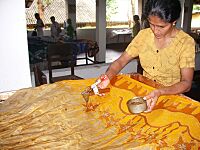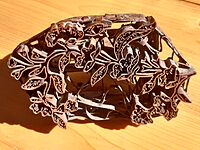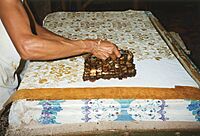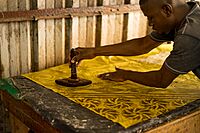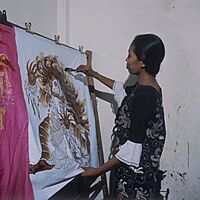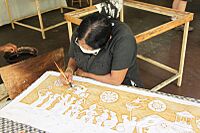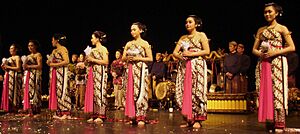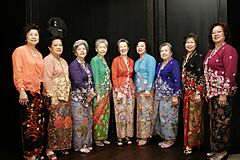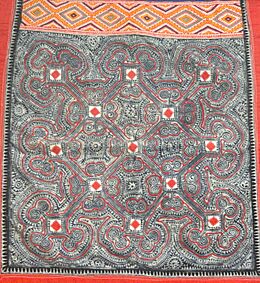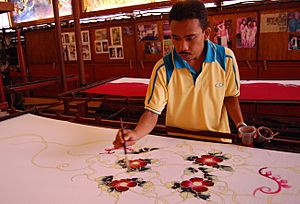Batik facts for kids
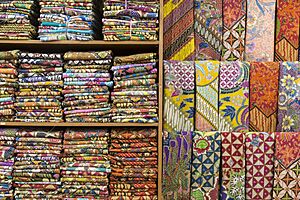
Cirebon-style batik at the Trusmi Batik Village, West Java
|
|
| Type | Art fabric |
|---|---|
| Material | |
Batik is a special art technique used to decorate cloth. It uses wax to create beautiful patterns. The word "batik" can mean both the technique and the finished cloth.
To make batik, artists draw or stamp patterns on fabric with hot wax. Then, they dip the fabric in dye. The wax blocks the dye, so the covered parts stay the original color. After the dye dries, the wax is removed. This reveals a colorful pattern. Artists can repeat this process with different colors to create very complex designs.
Batik patterns can be very different depending on where they are made. Some patterns have special meanings and are only worn for certain events. Others are created to follow modern fashion trends.
This art form has been practiced for centuries in many parts of the world, including Egypt, China, India, and Nigeria. However, the batik from the island of Java in Indonesia is famous for being one of the most detailed and artistic.
Contents
Where does the word "Batik" come from?
The word batik comes from the Javanese word bathik. It is related to an ancient word that means "patterns" or "decorations." The technique became well-known outside of Southeast Asia in 1817, when it was described in a book called The History of Java.
The Story of Batik
Ancient Roots
- Ancient pieces and representation of Resist dyeing using wax
Using wax to resist dye is a very old art. In ancient Egypt, it was used to wrap mummies. The technique was also found in China during the Tang dynasty and in Japan during the Nara Period. In Africa, the Yoruba people in Nigeria and the Soninke and Wolof people in Senegal also practiced this art.
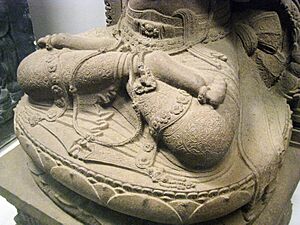
The art of batik is most famous on the island of Java, Indonesia. It is hard to know exactly when it started because cloth doesn't last long in a tropical climate. Some experts think the technique was brought from India or Sri Lanka in the 6th or 7th century. Patterns on ancient statues in Java look very similar to batik, which suggests it existed during Java's Hindu-Buddhist period (8th-16th century).
The oldest known piece of Javanese batik was found to be from the 13th or 14th century. This shows that skilled batik making was already happening at that time. The craft grew even more popular in the royal courts of Java in the centuries that followed.
Modern Times
- Modern pieces and representation of batik cloths
-
Waxprint fabrics in Togo, a modern African style inspired by Javanese batik.
Batik became more famous around the world after it was described in the book The History of Java in 1817. Europeans began collecting and studying batik. In the 19th and early 20th centuries, new ideas were introduced. For example, copper stamps were created to apply wax much faster than drawing by hand. This allowed batik to be made in larger quantities.
During this time, Javanese batik also spread to other parts of the world. In Subsaharan Africa, merchants introduced it, and local artists adapted it to create what is now known as African wax prints. These prints often have larger patterns and brighter colors.
Today, many artists and workshops continue to make batik. They create everything from traditional clothing to modern art.
How Is Batik Made?
The first step is to prepare the cloth by washing and soaking it. Then, artists draw a pattern with a pencil. After that, they trace the pattern with hot wax. The wax acts as a barrier to the dye.
The wax can be applied in different ways. The two main methods are "written batik" and "stamped batik."
Written Batik (Batik Tulis)
Written batik, or batik tulis, is made by drawing the wax onto the cloth using a special tool called a canting. A canting is like a pen with a small copper cup to hold the melted wax and a spout to let it flow out.
This method allows for very fine lines and detailed patterns. However, it takes a very long time to make a single piece of cloth, so batik tulis is often more expensive.
- Written batik using a ''canting''
-
Artists in Java drawing patterns with a canting.
Stamped Batik (Batik Cap)
Stamped batik, or batik cap, is made using a stamp called a cap. The cap is usually made of copper strips that are shaped into a pattern. The artist dips the cap in hot wax and then presses it onto the cloth.
This method is much faster than using a canting and makes it easier to create repeating patterns. While it is less detailed than written batik, it still requires a lot of skill to line up the patterns correctly.
- Stamped batik using a ''cap''
-
An artist in Mali stamping a pattern onto fabric.
Painted Batik (Batik Lukis)
Painted batik, or batik lukis, is a more modern technique. Artists paint the wax onto the cloth with tools like brushes. This allows them to be more creative and make unique, one-of-a-kind designs, similar to painting on a canvas.
- Painted batik using brushes
-
An artist in Yogyakarta uses a brush to create a large wax design.
-
An artist in Sri Lanka paints with wax using a brush.
The Dyeing Process
After the wax is applied, the cloth is dipped into a vat of dye. The waxed parts resist the color. Once the cloth is dry, the wax is removed by boiling the cloth in water or scraping it off. To add more colors, the artist can apply new wax patterns and dip the cloth in different dyes.
Long ago, all dyes came from plants, which made the process tricky. Today, many artists use synthetic (man-made) dyes, which are easier to use. However, some artists still prefer natural dyes because they are better for the environment.
What Do the Patterns Mean?
Batik patterns often have special meanings that come from the culture of the people who make them. In Indonesia, some patterns were once reserved for royalty or for special ceremonies like weddings. These patterns might include symbols with deep meanings.
Other patterns were created simply for fashion or to sell at the market. The table below shows some of the cultural influences on Indonesian batik patterns.
| Cultural influences | Batik patterns | Geographic locations | Sample |
|---|---|---|---|
| Native Indonesian | Kawung, ceplok, gringsing, parang, lereng, truntum, sekar jagad (combination of motifs) and other decorative motifs such as of Javanese, Dayak, Batak, Papuan, Riau Malay. | Respective areas with their own patterns | 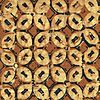 |
| Hindu–Buddhist | Garuda, banji, cuwiri, kalpataru, meru or gunungan, semen rama, pringgondani, sidha asih, sidha mukti, sidha luhur | Java | 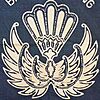 |
| Islamic | Besurek or Arabic calligraphy, buraq | Bengkulu, Cirebon, Jambi |  |
| Chinese | Burung hong (Chinese phoenix), liong (Chinese dragon), qilin, wadasan, megamendung (Chinese-style cloud), lok tjan | Lasem [id], Cirebon, Pekalongan, Tasikmalaya, Ciamis | 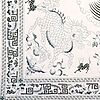 |
| Indian | Jlamprang, peacock, elephant | Cirebon, Garut, Pekalongan, Madura | 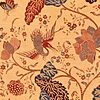 |
| European (colonial era) | Buketan (floral bouquet), European fairytale, colonial images such as house, horses, carriage, bicycle and European-dressed people | Java | 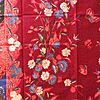 |
| Japanese | sakura, hokokai, chrysanthemum, butterfly | Java | 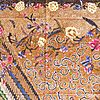 |
Batik Around the World
Indonesia
- Batik as worn in Indonesia
-
Dancers performing a royal dance from Surakarta wear costumes with special batik patterns.
Batik is a very important part of Indonesian culture, especially in Java. It is worn for everything from everyday outfits to important ceremonies. Certain patterns were once only for royalty, but today, people wear all kinds of batik designs.
On October 2, 2009, UNESCO named Indonesian batik a Masterpiece of Oral and Intangible Heritage of Humanity. Since then, Indonesia celebrates National Batik Day every year on October 2.
Africa
African wax prints were inspired by Indonesian batik. In the 19th century, Dutch merchants tried to sell machine-made batik in Indonesia, but it wasn't popular. However, these fabrics were a big hit in West and Central Africa. African artists adapted the style, creating their own bold designs.
Former South African President Nelson Mandela was famous for wearing colorful patterned shirts, which became known as "Madiba shirts." These shirts were inspired by Indonesian batik.
China
In Southwest China, ethnic groups like the Miao, Bouyei, and Gejia make batik for their traditional clothing. They use it to decorate skirts, jackets, and baby carriers. Their patterns often include symbols like dragons, phoenixes, and flowers.
Malaysia
Batik from Malaysia is known for its large, simple patterns and bright colors. Malaysian artists often use brushes to paint the colors on, which is different from the dipping method used in traditional Javanese batik. The most popular designs are leaves and flowers. This is partly because Islamic tradition discourages showing images of humans or animals in art.
Sri Lanka
Batik making has become a popular craft in Sri Lanka. It is a small-scale industry that allows artists to create their own unique designs. Many batik shops and galleries can be found in tourist areas, where they sell everything from clothing to wall art.
See also
 In Spanish: Batik para niños
In Spanish: Batik para niños
- Bagh print
- Balinese textiles
- Folk costume
- Tenun
- Ikat
- Malong
- National costume of Indonesia
- Screen printing
- Songket
- Textile printing
- T'nalak
- Tsutsugaki, Japanese resist-dyeing using starch, not wax


